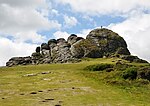Hound Tor
Archaeological sites in DevonCommons category link is locally definedDartmoorDeserted medieval villages in EnglandEnglish Heritage sites in Devon ... and 1 more
Tors of Dartmoor

Hound Tor is a tor on Dartmoor, Devon, England and is a good example of a heavily weathered granite outcrop. It is easily accessible, situated within a few minutes from the B3387 between Bovey Tracey and Widecombe-in-the-Moor. The site is administered by Dartmoor National Park Authority for English Heritage as it includes the ruins of a medieval village, alongside prehistoric works of stone construction nearby.
Excerpt from the Wikipedia article Hound Tor (License: CC BY-SA 3.0, Authors, Images).Hound Tor
Becca Brook Clapper Bridge, Teignbridge
Geographical coordinates (GPS) Address Nearby Places Show on map
Geographical coordinates (GPS)
| Latitude | Longitude |
|---|---|
| N 50.59623 ° | E -3.77878 ° |
Address
Cairn Circle and Kist
Becca Brook Clapper Bridge
TQ13 7TT Teignbridge
England, United Kingdom
Open on Google Maps








